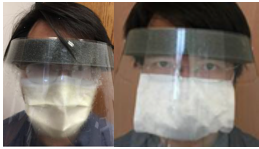Inventors at Georgia Tech and Emory have developed a modified face mask with an engineered ventilation layer over the upper portion of the face mask to ventilate air exhaled by the wearer with no added breathing resistance. The top and bottom edges of the ventilation outer layer may be easily bonded to mask by conventional heat sealing, sonic or other bonding techniques. Opposite side edges of the ventilation layer are not bonded with face mask, thereby allowing free movement of exhaled air through two side openings. The new face mask provides economical fog-free use with inexpensive standard face shields.
- Unique- fog-free patient eye-contact
- Non-invasive- reduced stress in extended medical staff contact with patients
- Simple- economical and durable
- Medical applications where a face mask is needed
Face masks are in the medical profession for face-to-face communication between medical staff and patients without risk of transferring infectious agents. It is often desirable to wear a face shield in conjunction with a face mask for additional protection from contaminated fluid that may enter medical worker's eyes, nose, or mouth. Unfortunately, the use of face shields in both medical and industrial applications leads to fogging of the shield with loss of visibility. Warm, moist exhaled air tends to condense on relatively cool surfaces of face shield in the proximity to the nose or mouth of the user, causing fogging and poor visibility.

